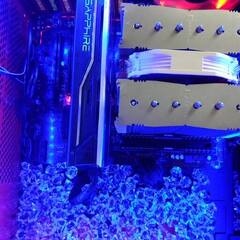-
Posts
284 -
Joined
-
Last visited
Reputation Activity
-
 SubLimation7 got a reaction from throwawayManMode in Gamers Nexus alleges LMG has insufficient ethics and integrity
SubLimation7 got a reaction from throwawayManMode in Gamers Nexus alleges LMG has insufficient ethics and integrity
I have always suspected he runs off of greed...
Now it is confirmed.
-
 SubLimation7 got a reaction from ddpp in Gamers Nexus alleges LMG has insufficient ethics and integrity
SubLimation7 got a reaction from ddpp in Gamers Nexus alleges LMG has insufficient ethics and integrity
I have always suspected he runs off of greed...
Now it is confirmed.
-
 SubLimation7 reacted to Glenwing in Buy new monitor or wait (displayport 2.0 & PG27UQ)
SubLimation7 reacted to Glenwing in Buy new monitor or wait (displayport 2.0 & PG27UQ)
The DP 2.0 specification only released a few months ago. VESA likely won't publish a CTS and begin certification testing for another year or two, so I'd estimate it will be roughly 2-3 years before the first DP 2.0 products appear at the earliest. And given past trends it will probably be 4-5 years before NVIDIA releases a G-Sync module for it, if they continue making those at all...
There is no possibility of a mod, the DisplayPort controller isn't on its own separate chip.
-
 SubLimation7 reacted to TheFlyingTraut in Creative cable run ideas/options (VR is making me sad)
SubLimation7 reacted to TheFlyingTraut in Creative cable run ideas/options (VR is making me sad)
Look up HDMI balun systems. Basically runs hdmi over Ethernet with powered ports on each end so it considerably lowers latency and greatly increases quality over long hdmi runs or bs wireless hdmi adapters.
Hdmi balun systems can get expensive but is very worth it if you’re going to use it. We used balun systems in big home builds where the component rack was maybe hidden on a different floor and was able to run hdmi to every room in the house. Big budget stuff. But they can be affordable if you’re just going to run one line and have a purpose for it.
You can pm me if you have any specific questions or want some input on some that you might find.
-
 SubLimation7 reacted to Hogblood in Creative cable run ideas/options (VR is making me sad)
SubLimation7 reacted to Hogblood in Creative cable run ideas/options (VR is making me sad)
Perhaps use displayport to carry audio and USB - not sure what the distance limit is without a repeater. A display port to HDMI adapter will preserve audio but USB will be lost. Maybe there is a hub that breaks out USB and HDMI from display port. Only thing would be making sure the 4k signal wouldnt be limited to 30Hz. I would look into it more but I dont have much time - good luck
-
 SubLimation7 reacted to TheFlyingTraut in Creative cable run ideas/options (VR is making me sad)
SubLimation7 reacted to TheFlyingTraut in Creative cable run ideas/options (VR is making me sad)
A 100ft cable, with fiber or not built in will still have losses. Those cheap powered extenders do not work. Just trying to save you the headache and hassle.
-
 SubLimation7 got a reaction from SocomSuade in TCL 55S17 vs 55R617 (2018 5 vs 6 series)
SubLimation7 got a reaction from SocomSuade in TCL 55S17 vs 55R617 (2018 5 vs 6 series)
Sorry to revive an old thread. But I was just crazy and over analytical when I first received the 6 series.
I did some back and forth testing, the 6 series seriously outshines the 5 series. And after using it for a couple months now I am extremely happy with the purchase considering price.
-
 SubLimation7 reacted to MkaiL in 1080ti ftw3 made me sad, are the S/N stickers supposed to look like this?
SubLimation7 reacted to MkaiL in 1080ti ftw3 made me sad, are the S/N stickers supposed to look like this?
Because yours has it doesn't mean they all do. I have a ftw3 myself and it doesn't whine at all, not even with a full cover block which usually even makes it more noticeable.
That's for protection so that you can't peel the sticker off and put it on another card. It will rip apart if you try.
-
 SubLimation7 reacted to an actual squirrel in Creative AE-5 headphone gain selection (Oppo Pm-3 specifically)
SubLimation7 reacted to an actual squirrel in Creative AE-5 headphone gain selection (Oppo Pm-3 specifically)
For gain settings, use the lowest setting that doesn't result in audio being too quiet. It does lower the power, but you are going to be lowering the power anyway with the volume control.
-
 SubLimation7 reacted to xtroria in Oppo Pm-3 second thoughts?
SubLimation7 reacted to xtroria in Oppo Pm-3 second thoughts?
When you upgrade to a headphone with the overall similar sound signature, the upgrade in sound quality won't be immediately noticable. It's only after you use the headphone for like a month or so regularly and then trying to go back to the old one you'll realize more about the difference in the sound
-
 SubLimation7 got a reaction from burnttoastnice in Theoretical AC vs DC question regarding future of electricity and PCs
SubLimation7 got a reaction from burnttoastnice in Theoretical AC vs DC question regarding future of electricity and PCs
Now that makes a bit more sense lol!
I was quite confused on the contradiction between the 1st and 2nd half of your post, you sounded very knowledgeable at first and then I was like... um.... lol
-
.png) SubLimation7 reacted to burnttoastnice in Theoretical AC vs DC question regarding future of electricity and PCs
SubLimation7 reacted to burnttoastnice in Theoretical AC vs DC question regarding future of electricity and PCs
I was under the impression that you suggested the motherboard did all the power conversion (which would eliminate the need for a PSU, seeing as the power coming from the wall would be DC) which would mean all the power delivery equipment gets relocated onto the motherboard. The rest of the post is basically based on this impression, so if that's not what you meant then ignore
Power supplies currently have one giant fan cooling things down, but if that power conversion equipment is moved onto the motherboard, there'd probably be a 110V DC to 12V DC supply for the PCIe, another 110v DC to 12v DC for the CPU power delivery (higher overclocks yay!), and another 110v to 5v for the USB (and coming from that some lower power 3.3v for the chipsets, and 1.3v for the RAM, but these don't need cooling). The PCIe and CPU power modules on the motherboard would probably be expected to handle up to 10A, maybe 20-40A for an enthusiast board.
That's easily 120W in two different places of the motherboard generating heat, along with heat losses in the CPU VRMs, a fan would be a necessity to keep these cool. Clever heatsink designs could let the user rely on system fans to keep everything on the motherboard running at a decent temperature, but ultimately custom water loop users would have the better looking motherboards and more effective cooling, provided the motherboard is a massive water block.
But lower power systems wouldn't need any kind of additional cooling - take the Pico PSU for example, which is capable of a beefy 160w power output without needing any kind of cooling at all. If anything, the motherboard would just need a 12v input brick, with the required power delivery scaled back and located on a small heatsink somewhere (if necessary). The external pico PSU brick would obviously get warm during high load, but if any heat-related fault develops with it, replacement is a simple task. If everything's integrated onto the motherboard and a heat-related fault develops, that could be an expensive problem
-
 SubLimation7 reacted to don_svetlio in Graphics card TDP and Power Consumption Explained
SubLimation7 reacted to don_svetlio in Graphics card TDP and Power Consumption Explained
So, seeing as there seems to be a bit of misconception about what TDP and Power Draw are exactly and how they correlate so I decided to try and explain it as best I can.
For testing purposes and in order to avoid brand bias - I will be using the GTX 760 and GTX 960 as my main sources for the numbers and measurements. Here goes nothing.
TDP:
The thermal design power (TDP), sometimes called thermal design point, is the maximum amount of heat generated by the Central/Graphics Processing Unit that the cooler attached to it has to dissipate under normal operation. TDP does not account for power viruses (furmark, kombustor, prime95) or any other sort of torture test and can easily exceed a product's rated TDP if one of those is applied.
Since safety margins and the definition of what constitutes a real application vary among brands, TDP values between different manufacturers cannot be accurately compared. For example, while a graphics card with a TDP of 200 W will almost certainly use more power at full load than a GPU with a 190 W TDP from the same manufacturer, it may or may not use more power than a GPU from a different manufacturer that has a 190 W TDP.
The dynamic power consumed by a switching circuit is approximately proportional to the square of the voltage:
P=CV2f
where C is capacitance, f is frequency, and V is voltage.
Now, boring math aside. Let me get more into the part of how exactly heat is generated and what affects the TDP of each graphics card, to some extent.
As we all know - each GPU core has an absurd amount of transistors we hear AMD or Nvidia brag about.
Nvidia:"Titan X has 8 billion transistors!"
AMD:"Oh yeah? Fury X has 8.9 billion transistors!"
...and this goes on...
So what's the significance of said transistors for TDP? Why am I bringing it up? Well - as we all know - by lowering the manufacturing process we usually have an increase in transistor count to go with it. Going to a smaller die size usually means reduced power as it allows the voltage across the transistors to be reduced. That also increases speed as the channel is now shorter so you can have faster switching transistors or more complex architectures running at the same speed. And as we all know - the lower the voltage applied to transistors - the less heat they generate. So say - if GPU A (which is 40nm) has 1B transistors @ 1.5V it would output more heat than GPU B (which is 28nm) with 1B transistors running @ 1.25V. Now. Although process shrinkage and transistor count cancel each other out to some extent - because GPUs have been stuck on the same 28 nm process for the last 3-4 years - we have only seen an increase in transistor count and thus an increase in temps as more transistors = more heat generation = higher TDPs. So, why is the 960 suddenly so much cooler than the 760? Well. It has less transistors. The 760 (3.5B transistors) has a TDP of 170W. The 960 (2.94B transistors) has a TDP of 120W. Yet, the 960 outperforms the 760 consistently and by a decent bit. Well - that's architecture for you. Optimization goes a long way. Realistically, the TDP in Maxwell wasn't achieved magically but by reducing the amount of heat-generating components of the GPU core. Now - it's nowhere near as simple as transistors being the only important thing - there are other factors as well.
Now that we've established what exactly produces the heat and how process shrinkage affects it - let's move onto the most frustrating part - power draw.
Power Consumption
Now - remember the TDPs of the cards we're looking at? 120W for the 960 and 170W for the 760. Well - according to bit-tech and anandtech - those TDPs have little to do with how much power each card actually pulls.
Bit-tech used Unigine valley to determine GPU power-draw as they deem it to be mostly GPU-centered. Using a watt meter - they determine the 960 system using about 240W of power and the 760 system about 300W.
Anandtech use "Battlefield 3" as it's an actual game and got a reading of the 760 system using 335W of power from the wall. I couldn't find them doing a similar test for the 960 but taking the offset of 30W from the other test - It'd be safe to assume a 960 test bench would use about 275W of power for the whole system.
Factoring out about 100W in both cases of the game benchmark for the CPU, HDD and RAM and we have these estimates. The 960 uses about 175W of power and the 760 uses about 235W of power.
Going back to the TDP of the card - 120W(draws 175W) for the 960 and 170W(draws 235W) for the 760. Suddenly - we see how TDP does not accurately reflect how much power GPU A or GPU B would draw. In most cases - power draw is "guessed" based on TDP and sometime that's somewhat accurate but usually it's totally wrong.
Now - I'm sure everyone and their grandma can throw an infinite amount of benchmarks showing GPU A, B or C drawing less power than my speakers but you need to remember that in order for these mid or high end products to actually deliver their rated performance, they also need the power. The thing is - Nvidia have managed to reduce the amount of heat given off by individual transistors better than AMD has and thus resulting in lower TDP - that causes people to immediately assume that you need a 1000W PSU to run a 380 and that you can run the 960 off a few potatoes and some wires. In almost all cases - that's totally wrong.
In order to accurately assess how much power a component is drawing, you need highly specialized testing equipment - such equipment is used by sites like Bit-tech or Anandtech in their testing and those test are almost always more accurate then a wild guess based on how much heat a certain component puts out. Example - the 7950 Boost has a TDP of 200W, yet draws exactly the same amount as a 760 - a card with a 170W TDP. Another example would be the 380 - it has a TDP of 190W - 70W more than the 960. In Legitreviews test, they used a P3 Kill-A-Watt power meter to determine that the 380 uses about 180W of power - almost identical power draw to the 960 but the TDP is vastly different. The same argument could be made about the 970 and 390 and so on.
All in all - I simply want to advise everyone to look for reputable sources with the appropriate equipment when researching power and thermals - do not simple decide that the card with the lower TDP will automatically draw less power. Always review the model
Small example
Sources:
http://www.legitreviews.com/sapphire-nitro-r9-390-8gb-nitro-r9-380-4gb-video-card-review_166123/11
http://www.bit-tech.net/hardware/graphics/2015/01/22/nvidia-geforce-gtx-960-review-feat-asus/10
https://www.techpowerup.com/reviews/Gigabyte/GTX_960_OC/25.html
http://www.anandtech.com/show/7103/nvidia-geforce-gtx-760-review/16
Tags to @Aniallation @STRMfrmXMN @EllieThePurpleFuzzy @quan289 @themaniac
Feedback, suggestions and corrections are appreciated. Thanks for your time
-
 SubLimation7 reacted to Godlygamer23 in Theoretical AC vs DC question regarding future of electricity and PCs
SubLimation7 reacted to Godlygamer23 in Theoretical AC vs DC question regarding future of electricity and PCs
You would still need power supplies to split the voltage between all the rails.
-
 SubLimation7 reacted to Theguywhobea in Theoretical AC vs DC question regarding future of electricity and PCs
SubLimation7 reacted to Theguywhobea in Theoretical AC vs DC question regarding future of electricity and PCs
You'd need voltage dividers but those are easy. The difference is that everyone would need a generator in their house as you can transmit DC long distances without significant losses like you can with AC. So you'd have a big ass generator in your basement you'd be pouring gas or diesel into everyday. Essentially there is no way Edison would have every really won in the long run, even if he had won back then.
-
 SubLimation7 reacted to cj09beira in Theoretical AC vs DC question regarding future of electricity and PCs
SubLimation7 reacted to cj09beira in Theoretical AC vs DC question regarding future of electricity and PCs
if i was trying to find that out, i would look no further than electromagnetism books and courses, as thats the physics behind all that, as ac is just an electromagnetic wave,
-
 SubLimation7 reacted to cj09beira in Theoretical AC vs DC question regarding future of electricity and PCs
SubLimation7 reacted to cj09beira in Theoretical AC vs DC question regarding future of electricity and PCs
if you find anything else, post it here i will make sure to follow this
-
 SubLimation7 reacted to cj09beira in Theoretical AC vs DC question regarding future of electricity and PCs
SubLimation7 reacted to cj09beira in Theoretical AC vs DC question regarding future of electricity and PCs
sure lets compare apples to oranges,
1 - the bigger energy consumers are usually large motors spinning things, which are more efficient under ac,
2 - the reduced amount of cables is actually a problem as its more expensive, because you need much thicker cable for dc, and 3 smaller cables actually reduce the amount of copper needed.
3 - lets compare a higher voltage system to a lower one and pretend it doesn't make a difference, it very well does, and its not a fair comparison.
3 - having 10% losses at the last meter of the system is much better than having the bigger losses on most of the line (in case of dc hardware)
-
 SubLimation7 reacted to burnttoastnice in Theoretical AC vs DC question regarding future of electricity and PCs
SubLimation7 reacted to burnttoastnice in Theoretical AC vs DC question regarding future of electricity and PCs
AC voltage is very interesting in itself.
It runs at a 50hz frequency (60hz in US), so it can be used as a timer in cheap products The EMF caused by switching from positive to negative so frequently allows AC voltages to be easily converted up and down just by using a transformer Using transformers to convert voltage allows supplies to be completely electrically isolated from mains, as power is transferred over a magnetic field The switching from positive and negative (sinusoidal nature) allows AC relays to operate at higher voltages without too much concern over arcing; as soon as a high current device gets disconnected, an arc forms for a fraction of a second until the voltage dips. Special arrangement of capacitors and bridge rectifiers allow AC voltages to be regulated into a positive and negative DC supply, i.e. +12v, 0v, -12v. Most older amplifiers use this kind of design internally
The motherboard does that to some extent already, but having the motherboard doing all the power conversion would make it much more expensive, having lots of metal blocks and random fans placed all over the place to cool down the power equipment. Plus, PCs wouldn't be as modular, and then the motherboards power delivery would be a limiting factor in how powerful a gpu can be installed etc unless gpus started shipping with dedicated power supplies.
-
 SubLimation7 reacted to Siedge in Theoretical AC vs DC question regarding future of electricity and PCs
SubLimation7 reacted to Siedge in Theoretical AC vs DC question regarding future of electricity and PCs
Solar generation happens at a DC level, so for instance, my solar goes from DC to A/C and then as devices get plugged in they convert back to D/C, rather inefficient and I've often thought at how nice it would be to not need that conversion.
-
 SubLimation7 reacted to Godlygamer23 in Theoretical AC vs DC question regarding future of electricity and PCs
SubLimation7 reacted to Godlygamer23 in Theoretical AC vs DC question regarding future of electricity and PCs
The motherboard already does that with the CPU and memory, but not to the same degree.
-
 SubLimation7 got a reaction from xg32 in Which z370 board would you choose and why?
SubLimation7 got a reaction from xg32 in Which z370 board would you choose and why?
I've got the MSI Tomahawk coming in Friday, only because of the value. I'll update this thread with build/delid/oc results.
-
.png) SubLimation7 reacted to xg32 in Which z370 board would you choose and why?
SubLimation7 reacted to xg32 in Which z370 board would you choose and why?
I know I'm gonna be broke after the 4k 120hz upgrade, 2080 ti (whatever they call it), probably a monitor that cost 1500-2000 dollars, hopefully the cpus now are just good enough.
-
 SubLimation7 got a reaction from Princess Luna in Which z370 board would you choose and why?
SubLimation7 got a reaction from Princess Luna in Which z370 board would you choose and why?
GPUS are gonna get pretty hardcore in the next couple of years... I'm excited... hdmi 2.1 4k 120 hz goal: early 2019 (for me)
-
 SubLimation7 reacted to Princess Luna in Which z370 board would you choose and why?
SubLimation7 reacted to Princess Luna in Which z370 board would you choose and why?
I meant the Aorus Gaming 7 specifically it is a bad board, about the 5ghz deal ^^
Either ways, overclocking might not even be needed, before when we were locked to 4 cores the only way to squeeze a bit more of performance was through the higher clock speeds yes but Intel was finally forced to give us six cores and that has given all the breathing room we needed to fully utilize even nVidia's highest end GPUs and at high resolutions like 1440p we're so GPU bond overclocking changes nothing:







